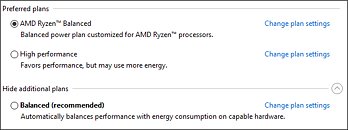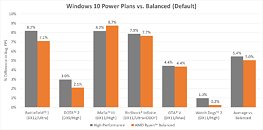Friday, April 7th 2017

AMD Releases Balanced Power Plan for Windows; Optimized for Ryzen Processors
In another Community Update from Robert Hallock, some more developments on the platform have been announced, after the last one's commitment to upcoming updates. AMD has done good on their promise for an optimized power profile for Windows systems that better leverages Ryzen's design and features.AMD's SenseMI technology allows the processor to fine-tune voltages and frequency on-the-fly, with a much higher granularity and lower latency than any software-based solution - such as Windows 10's power plans. These transitions between frequencies and voltages are governed by "P-States", which are frequency/voltage combinations requested by the operating system.
It so happens that Windows 10's Balanced power plan delays changes towards faster P-states - which bring increased frequency and voltage and hence, power consumption - so as to save more power. However, this means that there is an increased delay (latency) between the moment more processing power is required of the Ryzen processor and the moment the processor is allowed to change P-states to deliver it. Add to this the fact that Ryzen takes a significant performance hit with core-parking enabled, and Windows 10's balanced power plan attempts to park all logical processors beyond the first 10% whenever possible means that most of Ryzen's cores will have to be unparked before they can process any kind of workload - and this in itself incurs in an increased latency and, therefore, performance penalty.AMD's "Ryzen Balanced" power plan works by reducing the timers and thresholds for P-state transitions to improve clockspeed ramping, which lets the processor's SenseMI technology do its work; and disables core parking altogether (which really shouldn't be a problem, considering Ryzen's energy-efficient design.) AMD says that the performance gains are actually on par with the High Performance plan in various games, on a computer configured with an AMD Ryzen 7 1800X, a Gigabyte GA-AX370-Gaming5, 2x 8 GB DDR4-2933, a GeForce GTX 1080 (378.92 driver), and Windows 10 x64 (build 1607).AMD says there are other games they've seen benefits in (Total War: WARHAMMER, Alien: Isolation, Crysis 3, Gears of War 4, Battlefield 4, Project Cars and other unnamed ones). AMD says that not every game behaves in a way where a change in power plans has an impact on the Ryzen processor, but there is definitely a considerable number of them to warrant a change.
It really is commendable to see AMD so invested with its community updates, improving a platform that had some quirks on launch day (and still has, though fewer in number.)
Source:
Community @ AMD
It so happens that Windows 10's Balanced power plan delays changes towards faster P-states - which bring increased frequency and voltage and hence, power consumption - so as to save more power. However, this means that there is an increased delay (latency) between the moment more processing power is required of the Ryzen processor and the moment the processor is allowed to change P-states to deliver it. Add to this the fact that Ryzen takes a significant performance hit with core-parking enabled, and Windows 10's balanced power plan attempts to park all logical processors beyond the first 10% whenever possible means that most of Ryzen's cores will have to be unparked before they can process any kind of workload - and this in itself incurs in an increased latency and, therefore, performance penalty.AMD's "Ryzen Balanced" power plan works by reducing the timers and thresholds for P-state transitions to improve clockspeed ramping, which lets the processor's SenseMI technology do its work; and disables core parking altogether (which really shouldn't be a problem, considering Ryzen's energy-efficient design.) AMD says that the performance gains are actually on par with the High Performance plan in various games, on a computer configured with an AMD Ryzen 7 1800X, a Gigabyte GA-AX370-Gaming5, 2x 8 GB DDR4-2933, a GeForce GTX 1080 (378.92 driver), and Windows 10 x64 (build 1607).AMD says there are other games they've seen benefits in (Total War: WARHAMMER, Alien: Isolation, Crysis 3, Gears of War 4, Battlefield 4, Project Cars and other unnamed ones). AMD says that not every game behaves in a way where a change in power plans has an impact on the Ryzen processor, but there is definitely a considerable number of them to warrant a change.
It really is commendable to see AMD so invested with its community updates, improving a platform that had some quirks on launch day (and still has, though fewer in number.)



25 Comments on AMD Releases Balanced Power Plan for Windows; Optimized for Ryzen Processors
Great move to introduce a tool from AMD themselves to solve what MS should handle from start.
They raised the min processor state from 5% to 90%, so its almost HP in that regard.
It would be cool if @W1zzard could do a quick test to check idle clock speeds and power consumption using the Stock Balanced plan, the AMD Ryzen Balanced plan, and the High Performance plan.
Unless I'm completely misinterpreting what SenseMI is, which is completely possible.
JAT
Edit: Ninja'd by Newtekie
Test?
www.pcper.com/news/Processors/AMD-Releases-Ryzen-Balanced-Power-Plan-Test-Results-Inside
Minimum reported power usage at idle:
63.2w on Balanced (50% core park)
64.4w on BIOS forced max clock speed (Ryzen w/ .00025v reduction)
64.7w on Ryzen Balanced
65.0w on High Performance
67.1w on BIOS Fixed Voltage (Ryzen)
1.8w swing between Balanced and HP is pretty good.
Heh, I'll do my fine tuning manually trough the registry like before, same effect but I get to customize it :D
As for wattage usage, it should be extremely minimal when system is idle, only when some partial load would it go up anything noticeable.
This is a band aid/hack IMO until they fix it properly in OS or micro-code.
This could also be a side affect of having so many cores/threads but used on a low load app that only uses a handful. So you end up with low utilization on each core/thread so clocks don't ramp up fast.
If any OS can do that, its developer should win a special Nobel prize because that would be an earth-shattering development in artificial intelligence.
Of course AMD won't say it was Window's or Microsoft's fault. They would be the laughing stock with such a ridiculous claim. In fact it's only AMD's fault not doing all these tests BEFORE marketing the product and not issuing optimizations such as this (and probably more that's on the way) on day 1 (heck, day 0).
HW will always get ahead of SW and SW will always try to catch up with HW. Just because HW introduces new features and abilities and THEN code gets patched to take advantage of them. Don't try to make MS seem good and AMD bad for the windows not being able to take advantage of Ryzen's totally new arch. It is proven now that windows wasn't ready to show Ryzen's true potential in all cases and needed some patches, updates or even this script that AMD made themselves.
Why is it MS's responsibility for their OS to be READILY optimized for a completely new CPU architecture??
Really, you're contradicting even yourself: "HW will always get ahead of SW and SW will always try to catch up with HW. Just because HW introduces new features and abilities and THEN code gets patched to take advantage of them. "
This is correct, and it was never the OS developer's RESPONSIBILITY to optimize their OS for a new CPU architecture BY THEMSELVES. What happens typically, which is what also happened here, the CPU developer INFORMS the OS developer and CONTRIBUTES to said patches so everything works as it should. AMD can't expect anyone else but themselves to know all the ins and outs of their new CPU architecture.
AMD dropped the ball a little here, and I'm not trashing them for that, it's just the fact of the matter, as it is that they have limited resources to make everything perfect from day 1.
Business as usual. Everything that is new will require some time and usage to reach its full potential. Once you launch a product, you get massive amounts of data to act on and support findings to improve a piece of software or hardware.
If I got a new fangled GPU would it be upto MS for drivers and support, of course not.
Anyway, all this should of been taken care of months before release.
Also for last two gen Intel uses HW for speedstep tech, not relying on the OS, which ends up much faster latency response.
All in all, I'm not bashing AMD at all, and true that all new CPU architectures including Intel's had initial hiccups and everything got optimized as best they could in time. Same thing with AMD, which I'm rooting for. I'm on a mobile workstation now and can't see myself building a desktop in the near future (unless I win the lottery, lol), and I'm eagerly waiting for 8-core Ryzen parts inside a mobile workstation / desktop replacement notebook :toast:
You Seriously think that Microsoft would give AMD or Intel their Source Code to sort out the Windows O/S